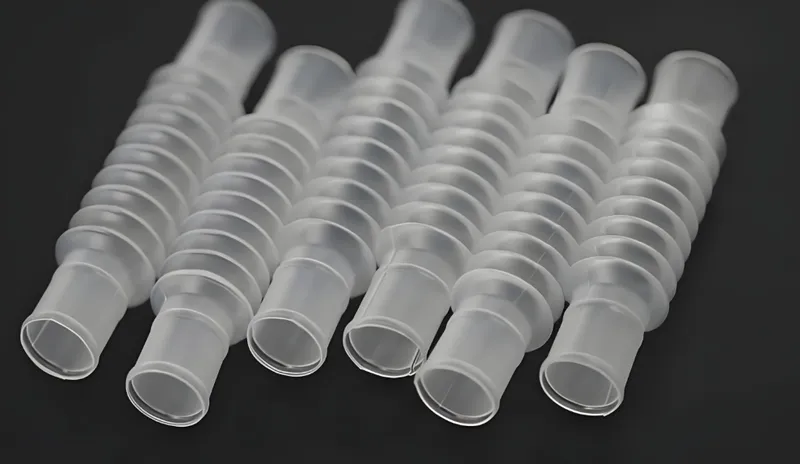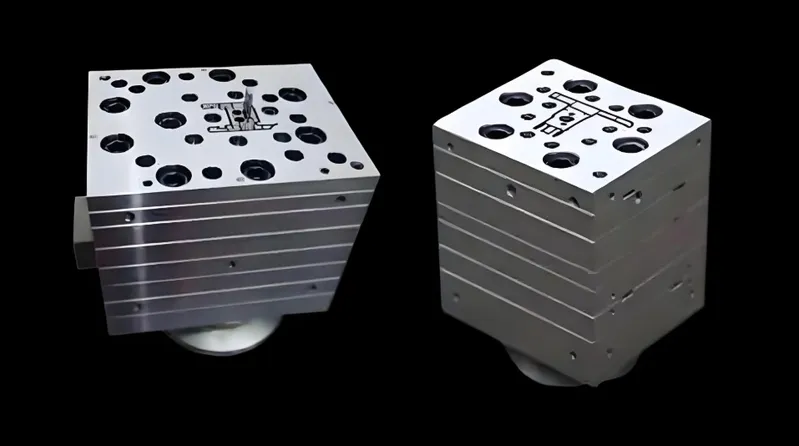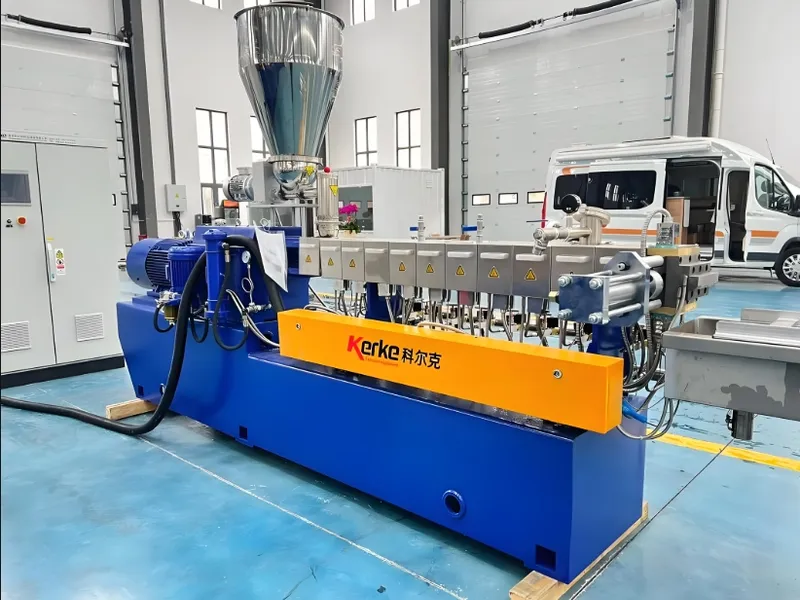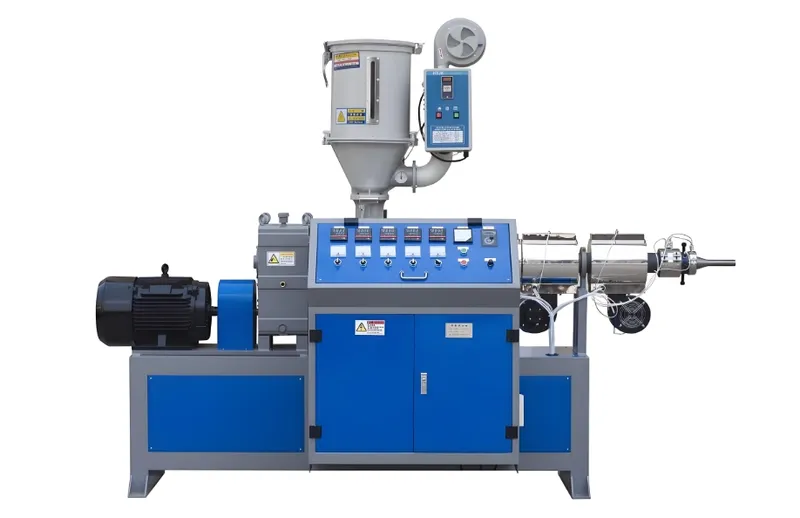
Air bubbles in TPE extrusion can compromise product quality, causing weaknesses and defects. Identifying causes and solutions is essential for maintaining material integrity.
Air bubbles in TPE extrusion result from moisture, incorrect temperature, or contamination. Solutions involve thorough material drying, optimizing temperatures, and maintaining clean machinery.
Understanding the root causes of air bubbles is critical to improving TPE extrusions. By addressing these issues, manufacturers can achieve more reliable and consistent product outcomes. Discover how specific solutions can enhance your extrusion processes.
Proper drying of TPE materials eliminates air bubbles in extrusion.True
Moisture in materials is a leading cause of air bubbles. Proper drying ensures air-free extrusion.
Higher extrusion speeds prevent air bubble formation in TPE.False
Excessive extrusion speed can increase air bubble formation due to insufficient material venting and heat distribution.
- 1. What is the Effect of Raw Materials on the Formation of Air Bubbles in TPE Extrusion?
- 2. How Does Process Control Contribute to the Creation of Air Bubbles in TPE Extrusion?
- 3. TPE Extrusion Does the Mold Design of the Product Affect the Possibility of Bubble Formation?
- 4. How Does the Condition of the Equipment Contribute to the Generation of Air Bubbles in TPE Extrusion?
- 5. What are the Solutions and Improvement Measures to Solve the TPE Extrusion Bubble?
- 6. Conclusion
What is the Effect of Raw Materials on the Formation of Air Bubbles in TPE Extrusion?
The quality of raw materials significantly influences air bubble formation in TPE extrusion, impacting product consistency and performance across applications.
Raw material properties influence air bubble formation in TPE extrusion by affecting melt viscosity and compatibility. Selecting and preparing materials correctly is crucial to avoid defects and ensure consistent quality.

Raw Material Issues
One of the main reasons for air bubbles in TPE is moisture or volatile substances1 in the material. These substances expand at high temperatures and create air bubbles. The quality of the raw material directly affects the bubble problem in TPE products. If the raw material contains too much moisture or volatile substances, it will easily lead to air bubbles inside the product.
Moisture and Volatile Substances in Raw Materials
One of the main causes of air bubbles in TPE extrusion is the presence of volatile substances. These substances expand at high temperatures and create air bubbles. The purity and particle size of the raw material can also affect the formation of air bubbles. If the raw material contains impurities or has an uneven particle size, it can cause uneven heating during the extrusion process, resulting in air bubbles. When selecting TPE raw materials, it is important to choose high-purity, high-quality materials with uniform particle size to minimize the formation of air bubbles.

Drying of Raw Materials
To get rid of the moisture and volatile substances in the raw material, you need to dry the raw material2. Before you extrude, you need to dry the TPE raw material enough to get rid of the moisture and volatile substances. You need to adjust the drying temperature and time according to the nature of the raw material and the performance of the extruder. If you don’t dry it enough, the moisture and volatile substances in the raw material will expand and make air bubbles when you extrude it. If you dry it too much, it will degrade the raw material and affect the quality of the extruded product.
Raw materials determine the number of air bubbles in TPE extrusion.True
The properties of raw materials influence melt behavior, affecting bubble formation and distribution.
All raw materials produce the same amount of air bubbles during TPE extrusion.False
Different raw materials have varying properties, such as viscosity and moisture content, which affect bubble formation differently.
How Does Process Control Contribute to the Creation of Air Bubbles in TPE Extrusion?
Effective process control is essential in minimizing air bubbles during TPE extrusion, enhancing product quality and consistency in industrial applications.
In TPE extrusion, process control optimizes temperature and pressure to minimize air bubbles, enhance product quality, and reduce waste. Essential for automotive and consumer goods, it involves precise monitoring and adjustments to ensure product uniformity.

Process Problems
When producing TPE products3, the process parameters like temperature, pressure, and time are very important for the quality of the products. If the temperature is too high, the water in the raw material will evaporate and generate bubbles.
If the pressure is not enough, the gas will not be completely discharged, which will also generate bubbles. The way of glue feeding will also affect the bubble problem inside the product. If the glue feeding is too fast and the pressure is too high, it is easy to wrap the air into the product, which will increase the generation of bubbles.
Improper Temperature Control
Temperature is one of the most important factors affecting the quality of TPE extrusion. In the extrusion process, if the temperature is not well controlled, it may cause air bubbles. If the temperature is too high, the water in the raw material will evaporate, causing bubbles in the material; if the temperature is too low, the fluidity of the material will be poor, and the gas will not be completely discharged.
In the extrusion process, according to the characteristics of the TPE raw material and the performance of the extruder, the temperature of the feeding section, melting section, homogenization section, and head section should be adjusted reasonably. The temperature of the feeding section is low, the temperature of the melting section and the homogenization section gradually increases, and the temperature of the head section should be slightly lower than the temperature of the melting section.

Another reason for air bubbles in TPE products is when the mold surface is too cold. When the mold surface is too cold, the molten material that touches it cools down too quickly and forms a skin on the surface. This skin prevents the gas inside from escaping. If the mold surface is too cold, the material will also be thicker and less fluid, which will make the problem worse.
Improper Control of the Release Agent
If you use too much release agent4 on the mold surface, it can cause bubbles in your TPE products. When you put release agent on the mold surface, it forms a film. This film helps the products come out of the mold, but it also gets in the way of the melted TPE and the mold touching each other. This makes it harder for gas to get out. Some release agents have stuff in them that can turn into gas when it gets hot. Then it makes bubbles.
Improper Pressure Control
Pressure has a big effect on how tight and smooth TPE extruded products are. When you extrude, if you don’t have enough pressure, you can’t get all the air out, and you’ll get bubbles in your product. You need to adjust the screw speed, die gap, and other things to control the extrusion pressure to a reasonable range. You also need to keep the extruder running steady so you don’t get big pressure swings that make bubbles.
Improper Control of Time
The time for melting and plasticizing is too short, which may cause insufficient mixing or melting of raw materials, affecting the elimination of gas. In the extrusion process5, the time for melting, plasticizing, and other processes should be reasonably controlled to ensure that the raw materials are fully mixed and melted. The extrusion speed and time should also be adjusted reasonably according to the wall thickness and shape of the product to avoid the generation of gas bubbles.
Process control reduces air bubble formation in TPE extrusion.True
By maintaining optimal temperature and pressure, process control minimizes the chances of air bubbles forming during extrusion.
All TPE extrusions will contain air bubbles regardless of process control.False
With precise process control, air bubble formation can be significantly reduced or even eliminated, improving the overall quality of the extruded product.
TPE Extrusion Does the Mold Design of the Product Affect the Possibility of Bubble Formation?
Mold design plays a critical role in HTPE extrusion, potentially affecting the likelihood of bubble formation during the process.
In HTPE extrusion, optimizing mold design by managing material flow, cooling rates, venting, and wall thickness minimizes bubble formation, enhancing product quality and reducing defects.

Poor Mold Exhaust SystemThe
The exhaust system of the mold is very important for the quality of TPE extrusion products. If the exhaust system of the mold is not good or not sealed well, the gas cannot be discharged smoothly, so there will be bubbles inside the product. When designing the mold, the exhaust system should be considered well to make sure the gas can be discharged smoothly. Also, the mold should be cleaned and maintained regularly to avoid the exhaust system being blocked and producing gas bubbles.
Mold Cooling System Unreasonable
When it comes to cooling and curing TPE extrusion products, the mold cooling system6 is a big deal. If the mold cooling system isn’t set up right or there’s too much of a difference in mold temperature, you could end up with internal stress during cooling, which could lead to air bubbles7.
When you’re designing your mold, make sure you set up the cooling system right so your products heat and cool evenly during the cooling process. You should also adjust the mold temperature and cooling time based on the thickness and shape of your products.
Mold design is the primary factor in bubble formation during HTPE extrusion.False
While mold design significantly impacts bubble formation, factors such as material properties and extrusion parameters are also crucial.
Proper venting in mold design reduces bubble formation.True
Effective venting allows trapped air to escape, preventing bubble formation and enhancing product quality.
How Does the Condition of the Equipment Contribute to the Generation of Air Bubbles in TPE Extrusion?
The equipment's condition plays a pivotal role in TPE extrusion, directly affecting the quality of the output, including the presence of air bubbles.
Properly maintaining extrusion equipment is key to minimizing air bubbles in TPE products. Optimize die calibration, feeding mechanisms, and temperature controls for smooth, consistent extrusion and high-quality output.

Equipment Problems
Air bubbles can also be caused by malfunctioning or poor production equipment. If the exhaust system is not good or the mold is not sealed well, the gas cannot be discharged smoothly, and air bubbles will be formed inside the product.
The design of the mold can also affect the bubble problem inside the product. If the gate location is not good, the gate is too small, or the runner is too small, the melt flow inside the mold cavity will be discontinuous, which will block the passage of air and generate air bubbles.
Failure of Production Equipment
If the production equipment, such as the melting equipment, plasticizing equipment, etc., fails or is in poor condition, it may also cause air bubbles during TPE extrusion. During the extrusion process, the production equipment should be regularly inspected and maintained to ensure that it is in good working condition. Also, based on the performance and use of the equipment, the process parameters should be adjusted reasonably to avoid equipment failure caused by bubble problems.

Improper Selection of Screw Speed
Screw speed is one of the important parameters that characterize the extrusion speed. If the screw speed8 is too slow, it will lead to insufficient extrusion volume and poor product compactness. If the screw speed is too fast, it may lead to problems such as rough product surface and internal bubbles.
In the extrusion process, we should choose the appropriate screw speed according to the characteristics of TPE raw materials and the performance of the extruder. According to the wall thickness and shape of the product, we should adjust the screw speed and extrusion speed reasonably to avoid the generation of air bubbles.
Regular maintenance of extrusion equipment reduces air bubbles in TPE products.True
Consistent upkeep ensures all components function properly, preventing defects like air bubbles.
The age of the equipment is the main factor causing air bubbles in TPE extrusion.False
While the age can play a role, regular maintenance and calibration are more crucial in preventing air bubbles, regardless of the equipment's age.
What are the Solutions and Improvement Measures to Solve the TPE Extrusion Bubble?
TPE extrusion bubbles can undermine the quality and consistency of products, necessitating effective solutions and improvement measures in manufacturing processes.
To eliminate bubbles in TPE extrusion, optimize temperature, speed, and material purity. This enhances product quality, material properties, and reduces waste.

Optimize the Selection of raw Materials and Pretreatment
When it comes to the causes of TPE extrusion bubble, you can start by optimizing the selection of raw materials and pretreatment. Choose high-quality raw materials with high purity and uniform particle size, and dry them well to remove the water and volatile substances. Depending on the application environment and requirements of the products, you should also choose suitable TPE raw materials and compatibilizers to improve the quality and performance of the products.
The first step to solve the problem of internal bubbles in TPE products is to strictly screen and control the raw materials. Make sure the moisture and volatile content of the raw materials are within a reasonable range, and avoid using raw materials with excessive moisture or volatile content. Dry the raw materials well to reduce the moisture content and minimize the generation of air bubbles.
Adjustment of Process Parameters
Based on the characteristics of TPE raw materials and the performance of the extruder, adjusting the process parameters reasonably is an important way to reduce the generation of air bubbles. By adjusting the temperature, pressure, time and other parameters, you can optimize the extrusion process and improve the quality of the product. The extrusion speed and time should also be adjusted reasonably according to the wall thickness, shape of the product and other factors to avoid the generation of air bubbles.
To effectively reduce the problem of air bubbles in TPE products, you can optimize process parameters like temperature, pressure, and time. Set process parameters reasonably based on specific production equipment and material characteristics to make sure the melt flows and exhausts fully in the mold cavity. Use low-speed, low-pressure glue feed to reduce the air wrapped in and minimize the generation of air bubbles.
Improvement of Mold Design
To solve the problem of air bubbles in TPE products, we need to optimize the mold design. We should set the gate location, gate size, runner diameter, and other parameters reasonably to make sure that the melt can flow continuously and smoothly in the mold cavity. We should increase the number and size of the venting holes to make sure that the gas can be discharged smoothly. We should also consider the impact of the mold cooling system design and the mold surface roughness on the internal gas bubbles in the products.

To reduce the generation of gas bubbles during TPE extrusion, improving the die design is one of the key measures. By optimizing the die’s exhaust system and cooling system, the denseness and surface quality of the products can be improved. Regular cleaning and maintenance of the mold should also be carried out to avoid air bubble problems caused by clogging of the exhaust system and malfunctioning of the cooling system.
Strengthen Equipment Maintenance and Management
Make sure to regularly check and maintain the production equipment to ensure that the exhaust system of the mold is good and tightly sealed. If there is any faulty production equipment, make sure to repair and replace it in time to avoid equipment problems caused by the bubble problem inside the product
To make sure the TPE extrusion process is stable, you need to have strong equipment maintenance and management. You should regularly check and maintain your production equipment. If you find any problems or if your equipment isn’t working well, you need to fix it right away.
If you don’t, you could end up with air bubbles in your product. You also need to have a system for managing your equipment and a plan for maintaining it. That way, you can make sure your equipment is always working well.

Continuous Quality Monitoring and Improvement
To make TPE extruded products better, we need to set up a quality monitoring system to test and evaluate them regularly. By collecting and analyzing quality data, we can find problems and fix them. We should also keep up with what’s happening in the industry and new technology. We should bring in new technology and equipment to make TPE extruded products better.
Control of Mold Temperature and the Use of Release Agent
To solve the problem of air bubbles inside TPE products, you need to control the temperature of the mold and use a release agent. Make sure the mold surface temperature is just right. If it’s too low, the melt will cool too quickly when it touches the mold, forming a cured layer on the surface. Use less release agent or switch to a silicone-free release agent to reduce the amount of gas generated and the formation of air bubbles.
Adjusting extrusion temperature can eliminate bubbles in TPE.True
Proper temperature control during the extrusion process ensures even melt flow and minimizes the occurrence of bubbles.
All TPE extrusion issues can be solved by changing the extrusion speed.False
While adjusting speed may alleviate some bubble issues, bubbles often result from various factors, including temperature and material purity, requiring a comprehensive approach for resolution.
Conclusion
Air bubbles during TPE extrusion are a big problem. There are many reasons for this, like the materials, the process, the mold, and the machine. To solve this problem, you need to look at it from different angles and think about all the factors. Then you can come up with some solutions and make some changes.
By optimizing the selection and pretreatment of raw materials, adjusting process parameters, improving mold design, strengthening equipment maintenance and management, and continuously monitoring and improving quality, we can greatly reduce the occurrence of air bubbles in TPE extrusion, improve product quality and market competitiveness, and create more economic and social benefits for the enterprise.
-
Understanding the role of volatile substances can help improve TPE product quality and reduce air bubbles. ↩
-
Proper drying techniques are crucial for preventing air bubbles in TPE products, ensuring better quality and performance. ↩
-
Explore this link to understand the best practices for producing high-quality TPE products and avoiding common issues like bubbles. ↩
-
Discover how release agents work in TPE production and their potential effects on product quality, including bubble formation. ↩
-
Learn about the extrusion process and its impact on product quality, including how to prevent air bubbles in TPE products. ↩
-
Understanding the mold cooling system is crucial for preventing defects like air bubbles in TPE products.Explore this link for in-depth insights. ↩
-
Learn about the causes of air bubbles in TPE extrusion to improve product quality and reduce defects. This resource provides valuable information. ↩
-
Discover how adjusting screw speed can enhance TPE extrusion quality and prevent issues like air bubbles. This link offers essential guidance. ↩








